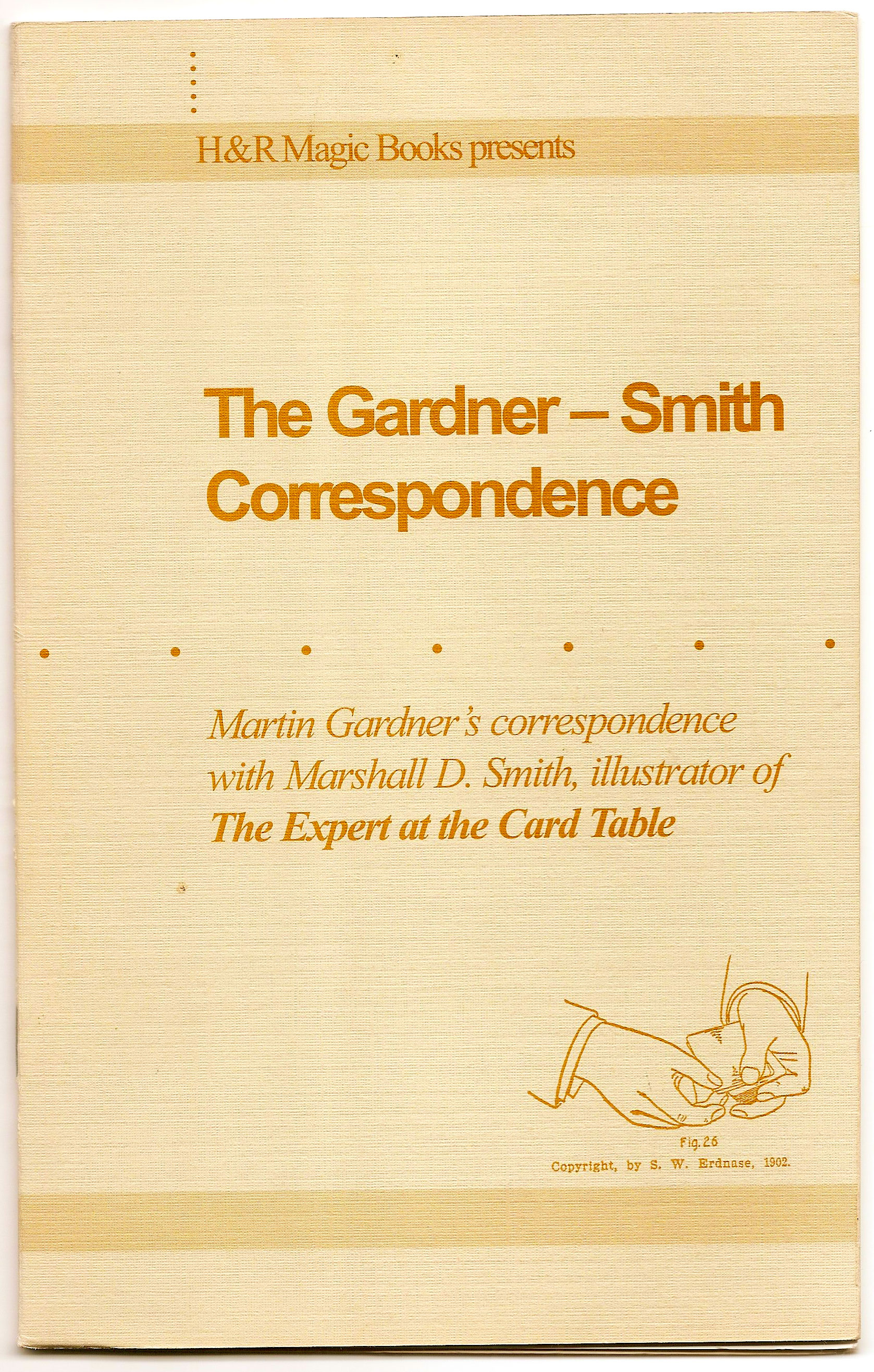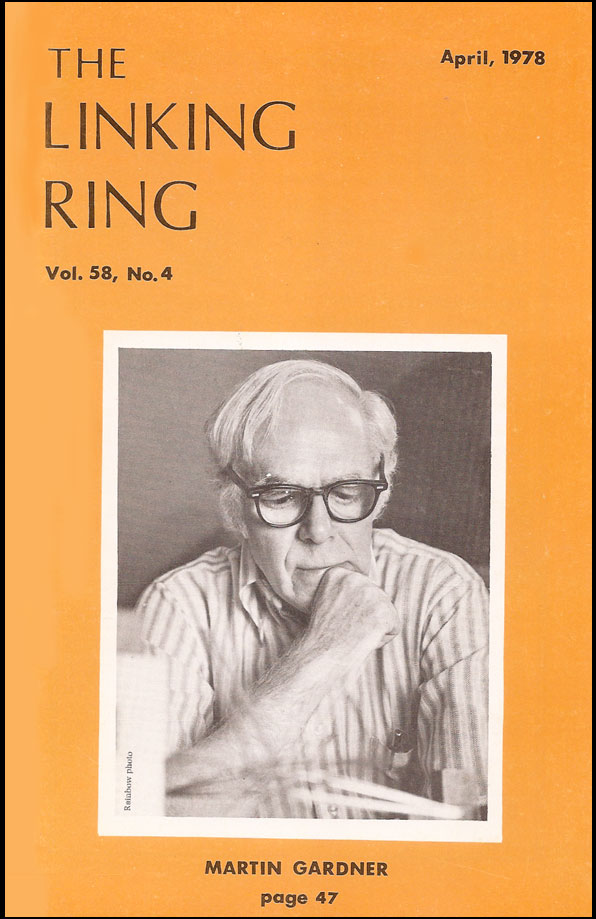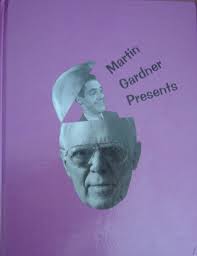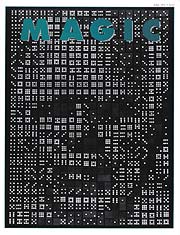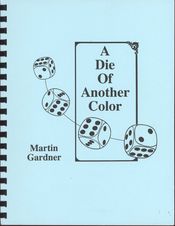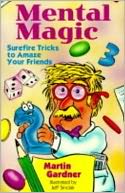Martin Gardner's Magic Output
Martin's magical interests were focussed on table and close-up magic, and from
the 1930s on, he published a lot of original magic. He is well known for his
innovative tapping and spelling effects, with and without cards, and was most
proud of his
Wink
Change.
There is a good brief bio and listing of some of his primary magic publications
at Genii
Magicpedia. Denis Behr has an accounting of many of Martin's published magic
at his excellent conjuring archive
(note that it can be ordered by title, source, year, etc.).
There is also a brief and hardly accurate biography of magical Martin at MagicNook.
Martin's first magic publication was a trick called "Color Divination" for the
Sphinx in May of 1930. He was fifteen years old, and would go on to
publish for a further 80 years, in a bewildering breadth of fields. The last
publication in his lifetime was a magic trick that he contributed to the May 2010
issue of Word Ways.
Happily, both tricks can be found together in this
80 Years of Gardner Magic article by Jerry & Karen Farrell.
He followed up with additional Sphinx items, including:
"Ring Off String" (Jul 1930),
"An Impromptu Trick" (Mar 1931),
"Try These on Your Chewing Gum" (Nov 1931),
"Impromptu Divination" (May 1933),
"Parlor Mind-reading with a Deck of Cards" & "Parlor Thought Transference" (Sep 1933),
"Comedy Card Spelling Routine" & "Crayons and Hat" (Feb 1934),
"A Four Ace Routine That Is Different" (Mar 1934),
"A Practical Coin Sleight" (Apr 1934),
"Two Decks, Two People, and a Magician" (Oct 1937),
"Magic With Chessmen" (Nov 1937),
"Dice, Hat and Matches" (Apr 1940),
"Gardner's Goofy Silks" (Dec 1940),
"More Goofy Silks" (Feb 1941),
"Army Guts Test" (Aug 1942), and
"Give-Away Cards For Table Workers" (Nov 1942). He'd enlisted in the Navy
in Sep 1942, and following his discharge in May 1946 and later move to NYC, he
published "The Magic of Dr. Jaks" (Feb 1949), and "The Vanishing Cigar"
(Dec 1952).
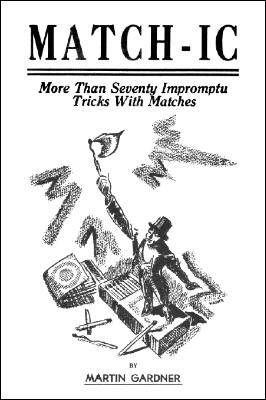
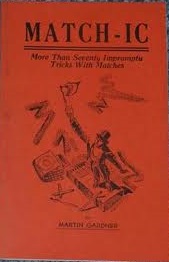
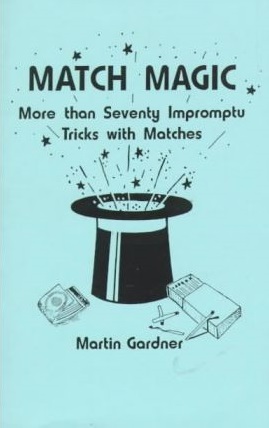
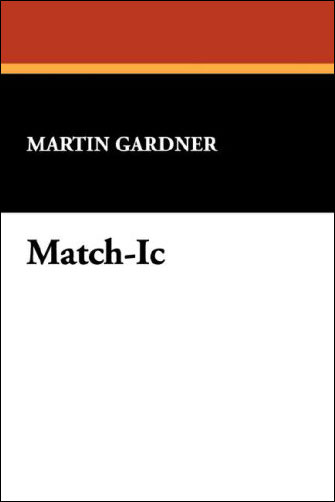
Match-ic: More
than Seventy Impromptu Tricks with Matches (Ireland Magic, 1935, 29
pages) was the first of seven magic pamphlets that Martin published between
1935 and 1949. There were also numerous additional mimeographed items also
sold through magic shops.
In "My Chicago Booklets" (Magicol, No 165, Nov
2007), Martin wrote of this:
"[I]t was the the second book devoted entirely to match tricks. (An earlier book
on the topic, by Will Blythe, had been published in England.) "
It was finally reissued as Match
Magic: More than Seventy Impromptu Tricks with Matches (Piccadilly,
1998, 48 pages), and again under its original title a decade later (Brownstone,
2007, 48 pages).
Here's New
Magic (1937, 20 pages) was credited to magician
Joe Berg, but was actually
ghostwritten by Martin. It features 23 effects, including the influential
"Gardner's Card Speller."
12 Tricks
with a Borrowed Deck (L. L. Ireland, 1940, 24 pages, illustrated by
Tarbell) was next. It includes "Double Climax Speller" and "Improved Lie
Speller." Max Maven ranks its "Never-Miss Stop Trick" among the Top
10 Martin Gardner Card Tricks.
After the
Dessert (Max Holden/L. L. Ireland, 1941, 28 pages, illustrated by
Nelson C. Hahne) contained 30 tricks. A version with only 24 tricks, and
Martin's own artwork, had circulated in 1940 in mimeographed form. The material
includes magic with money, matches, cigarettes, silverware, napkins and salt
shakers. In his Introduction, Martin writes:
"I have chosen only tricks which make use of objects found at any dinner table.
All are performed while seated, with spectators on both left and right."
"A few of the effects are original..."
Favorite
Mother Goose Rhymes (Sam Berland, 1941, 22 pages) was a forcing book. It
was republished in higher quality in London in 1953, and that version is included
in an article (pages 348–359) in the book Martin Gardner Presents
discussed below.
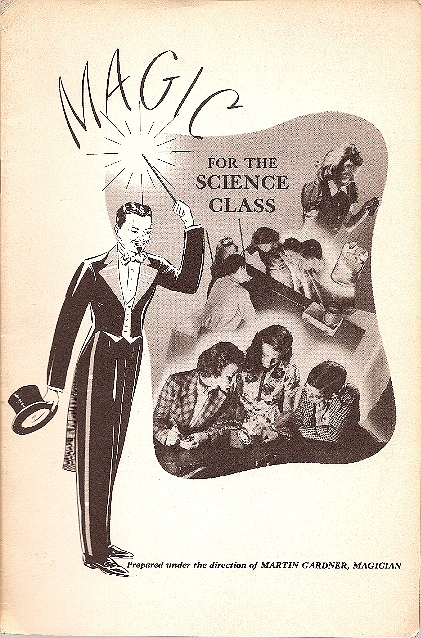
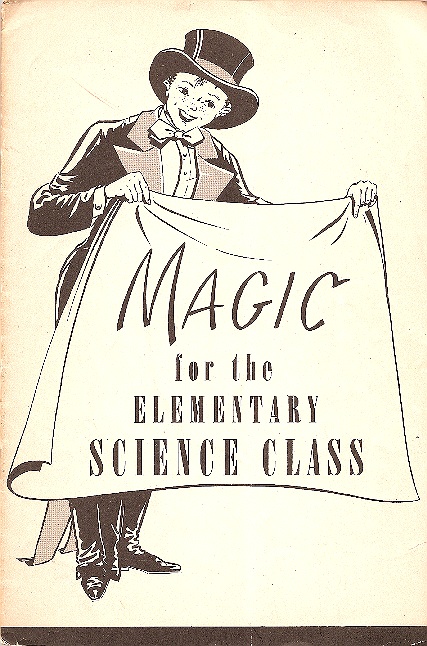
Magic for the Science Class (Scott, Foresman, and Company, 1941, 2 + 18
pages) and
Magic for the Elementary Science Class (Scott, Foresman, and
Company, 1941, 2 + 16 pages) came in rapid succession near the end of 1941, as
part of the "Discovering Our World" textbook series. They are discussed in
Physics)

Cut the
Cards (Max Holden Magic, 1942, 34 pages, illustrated by Nelson C. Hahne)
was later included in facsimile form (as pages 379–397) in the book
Martin Gardner Presents discussed below. Max Maven ranks its "Vanish and
Spell" among the Top
10 Martin Gardner Card Tricks.
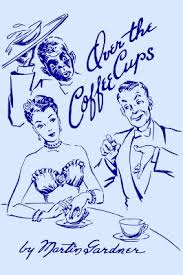 http://www.geniimagazine.com/magicpedia
http://www.geniimagazine.com/magicpedia
Following his 4 years in the Navy and stint in graduate school at the University
of Chicago—in fact after his subsequence relocation to NYC—a magic
friend in Tulsa, whom he's known when he was in high school, published Over the Coffee
Cups (Montandon Magic, 1949, 6 + 34 + 5 pages, illustrated by Martin himself).
It has over 80 tricks with sugar cubes, bills and coins, silverware, matches,
cigarettes and cigars, napkins, handkerchiefs, and the like.
Table Magic
(Dover, 1998, 137 pages) includes reorganized material from
Match-ic,
12 Tricks with a Borrowed Deck,
After the Dessert,
Cut the
Cards, and
Over the Coffee Cups.
On page 221 of Martin Gardner Presents (see below), discussing an old trick
of his called "Passe Passe Sponge," Martin writes:
"I have fond memories of setting up a table at the 1940 SAM annual conference, at
Chicago's Morrison Hotel, and demonstrating the trick hundreds of times. I met
many magicians for the first time, when they stopped to watch, and who later
became friends. One of them was Bob Hummer..."
"
In time, Martin not only came to know Hummer, but also Ed Marlo,
and other big names in magic.
Like many a keen card man, Martin had by the 1940s grown fascinated with
the legendary book 1902 Expert at the Card
Table and the question of the true identity of its author S. W. Erdnase. After he
got out of the Navy in the second half of 1946, he embarked on his own
investigations, having discovered that Marshall Smith, the man who illustrated
the book at the start of the century, was alive and living in Chicago.
Half a century later, Martin shared his findings via The
Gardner-Smith Correspondence (H&R Magic Books, 1999, 2 + 29 pages),
subtitled "Martin Gardner's correspondence with Marshall D. Smith, illustrator
of Expert at the Card Table." It details letters exchanged—and a
single meeting—between the two men in the period Dec 1946 to Jan 1953.
(By the end of the correspondence, Martin had long moved to NYC.) Geno Munari
included it as part his Erdnase DVDs.
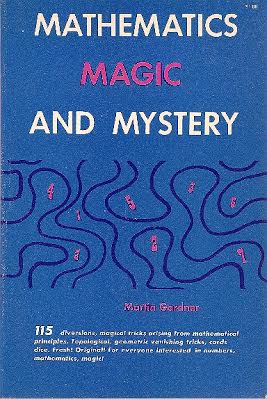
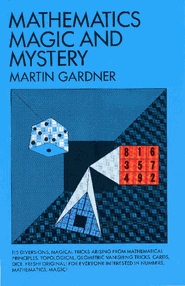
Martin's second published book—though the third he wrote—was Mathematics, Magic and Mystery (Dover, 1956), which
is still viewed as a classic almost 60 years later. It includes magic with
cards, dice, dominoes, calendars, watches, coins and paper money, matches,
checkerboards, handkerchiefs, clothing, string and rope, as well as strictly
mathematics-based material such as geometrical vanishes, "topologcal tomfoolery"
and magic squares, to effects with Fibonacci numbers, digital roots and casting
out nines. Thanks to Martin's personal acquaintances with top-notch
mathematically-inclined magicians such as Bob Hummer, who allowed him to publish
their clever creations, much of this was appearing in print for a general
audience for the very first time.
Encyclopedia of Impromptu Magic (Magic Inc, 1978, 574 pages) collects
magic effects that Martin published in Hugard's
Magic Monthly between Mar 1951 and Apr 1958. (No material on card
or rope magic is included.)
"I wrote my Encyclopedia mainly for the fun of it, and to get into some
sort of shape the thousands of notes I had scribbled over the years on
three-by-five cards."
"It was written quickly and carelessly, in an annoying telegraphic style intended
to compress as much as possible into the allotted space, and with almost no
attempt to research the magic literature."
"The work remains patchy and slovenly. It makes no pretense at completeness.
Excellent impromptu tricks are missing because I happened not to come across them."
This book has remained a favorite of many magicians over the decades. Teller
has said:
"There is no book in my library that has more little blue Post-It tabs than my
scuffed and dog-eared old Gardner Encyclopedia of Impromptu Magic."
It was finally reissued in much expanded form as
Impromptu
(The Magic Factory, 2015, 864 pages). This features more than 1700 effects and
stunts including 1200 extra items compiled by Gardner, incorporating material
he had accumulated on the subject since 1978.
It includes a Foreword by Teller and an Introduction by John Fisher, who says,
"[publisher] Todd Karr has now surpassed [original publisher] Jay Marshall's
achievement by augmenting and organizing the material in a way worthy of
Gardner's standing as the closest magic has produced to a Nobel laureate."
Over the decades Martin published magic in numerous outlets,
including
Conjurors' Magazine,
Ibidem,
Hugard's Magic Monthly,
The Phoenix,
The New Phoenix,
The Jinx,
Epoptica,
The Pallbearers Review,
Prototype,
The Linking Ring,
Genii,
The Chronicles,
The Magical Arts Journal,
Magick,
and The Magic Magazine.
In the 1970s, he also placed several items in the Indian Swami ("a monthly
magazine of exotic mysteries") and Mantra (Magic Monthly).
The Linking
Ring honored Martin with a cover story by John Braun in Apr 1978 (Vol 58,
No 4), and he was listed under "Broken Wand" in Jun 2010 (Vol 90, No 6)
following his death.
From 1990 to 2002, Martin contributed a "Trick of the Week" feature to The Physics Teacher
magazine, and from 1994 to 2004 some of these resurfaced with new art by Tom
Jorgenson in Magic
magazine under the banner "Martin Gardner's Corner."
Martin
Gardner Presents (Kaufman and Greenberg, 1993, 415 pages, illustrated by
Joseph K. Schmidt) collects a great deal of Martin's contributions to (quoting
from Max Maven's Introduction) "intraprofessional magic journals," going all the
way back to that first trick for the Sphinx in 1930.
Spanning six decades, the magic includes tricks with cards, coins, dice, ropes,
paper, and more. Martin's introduction sheds light on his personal relationships
with magicians and the world of magic, even explaining that he met his future
wife Charlotte through an introduction from magician Bill Simon. Magic publisher
and future Genii editor Richard Kaufman called Martin "an unceasing
pleasure to work with."
Martin made the cover of
Magic
magazine in Apr 1994 (Vol 3, No 8), in the form of
Ken Knowlton's domino
image, in connection with an interview by Tom Ransom.
Arcane (No 14, 21 Oct 1995) was titled "Special Issue: Martin Gardner" in honor of
Martin's 71st birthday. (It was the final issue of Jeff Busby's magic magazine.)
A
Die of Another Color (Karl Fulves, 1995, 4 + 40
pages, illustrated by Joseph Schmidt) is an insider treatise on controlling fair
dice, surveying the "meager literature" of the field and adding controls original
to Martin.
Mental Magic
(Sterling, 1999, Dover, 2010, 95 pages, illustrated by Jeff Sinclair) is
subtitled "Surefire Tricks to Amaze Your Friends." Its 89 predictive items are
seemingly aimed at a young audience, and range from simple gags and forces with
words, cards, dice and calculators, to classics by Bob Hummer, Paul Curry, George
Sands, Max Maven, and Karl Fulves, as well as Jim Steinmeyer's "Nine Card
Speller" from 1993. Much of the material is far from juvenile, such as the first
trick: a word-based version of the Kruskal Count.
In his later years, Martin published magic less frequently, but he did (in
hindsight) "sign off" with the May 2010 item mentioned at the start above.
In Martin Gardner Presents, he wrote, "I've often thought about writing
a book on magic for five-year-olds. I'll probably never get around to it...
This prediction turned out to be correct.
Items with a magical flavor appeared scattered across many other writings of
Martin's, from his Scientific American columns
and spin-offs, to his
numerous puzzle books.




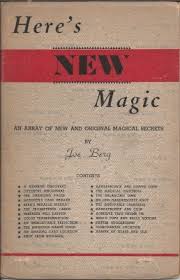
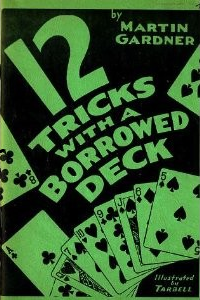





 http://www.geniimagazine.com/magicpedia
http://www.geniimagazine.com/magicpedia

